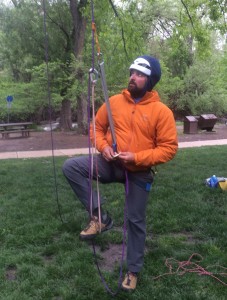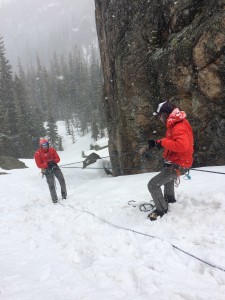Mia Tucholke, Recipient of the 2015 Petzl Scholarship
Mia Tucholke received the 2015 Petzl scholarship for her AMGA Alpine Guide Course in Boulder, CO. Check out her video from the course!
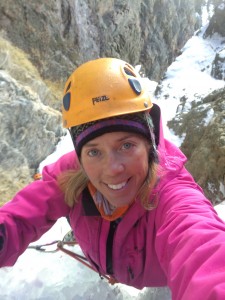
2015 Petzl Scholarship Recipient Mia Tucholke on the Dukes of Hazard, Rocky Mountain National Park (RMNP), Colorado. Photo: Mia Tucholke
The Alpine Guide Course in Boulder, Colorado, this past May was an excellent course taught by great instructors and shared with amazing peers. We had hoped for more (any?!) alpine time, but the weather and winds didn’t cooperate with us. Instead, we ended up with a techy course, something my engineering brain embraced with passion. So many skills, techniques, nuggets (but no tricks) were gained and practiced during the days spent together……..another yellow book filled with information!
As guides, we are fortunate to have these opportunities to take educational courses and to learn from the best. As guides, we shall embrace such training, if for nothing other than to broaden our knowledge and to stay up to date on modern technologies. Of course, the courses come at a price, but what education doesn’t? This year, I was honored to have received the Petzl full-tuition scholarship, hence making the Alpine Guide Course possible for me. And what an appropriate scholarship: helmets, harnesses, belay devices, carabiners were worn/used, and of course the mighty Micro Traxion, invaluable for haul systems. Yep, so many great products.
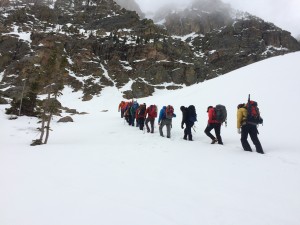
The whole Alpine Guide Course team heading up in Rocky Mountain National Park, Colorado. Photo: Mia Tucholke
Eldorado Canyon: What a perfect venue for wandering around, roped up, on challenging terrain. During our guide-demo day I was tied to a rope with Dale Remsberg. Now that man can move over terrain; if I can only someday move half as efficiently as he does, I will be very pleased. Practice and more practice. Of course, these are skills that cross over to the other disciplines, so lots of opportunities to keep practicing will follow.
The finer points of anchors, and how to use as little gear as possible (cause who wants to carry all that hardware?) were demonstrated by the instructor team. Hitches……yep, the clove and the Munter, we all know how to tie them…..right?! Of course, the air method is easy but directly on the anchor or on the harness, quickly, carabiner facing either way, client coming up or going to be lowered—we sure got to practice all of the above, over and over.
Short-roping and short-pitching and other miscellaneous methods to keep us and our clients attached to the mountain were also taught and practiced. The concept are so easy, but not always the efficiency. Practice….and more practice. Short-roping to failure (with a backup of course) was a great eye opener. I think I want all my clients to be small…… luckily, many options exist to keep us safe.
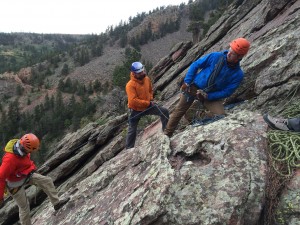
Jonathan Shrock shoulder-belaying Zach Novak while Geoff Unger watches, Eldorado Canyon, Colorado. Photo: Mia Tucholke
Ah, the First Flatiron! We did the complete AMGA team assault of this fun and easy Front Range classic climb. We went up and down, back and forth, in our approach shoes, using little to no gear, but using loads of terrain features. Equivocation hitches were practiced, horns were rapped, and two-nut anchors were utilized. Thanks to Jeff Ward for so much insight and for reminding us that guide security is still very important—even if the terrain is easy. Other climbers were out as well (it is Boulder, after all), many wondering who we were and if we actually did climb in our approach shoes? Plenty of time to chit-chat with the masses and to observe what may not always be best practices.
A day on snow in the Rocky Mountain National Park (RMNP). Gear selection, pickets, ice axes, crampons, and other miscellaneous and sharp hardware were discussed. B‐rated vs. T‐rated ice axes were compared, the difference in strength not that huge but enough. Steel and aluminum crampons, automatic, strap‐on, hybrid: many choices, just make sure you never ever forget the antibot plates!!! We learned that you have a 50/50 chance of connecting the Micro Traxion correctly the first time, although it seems you often get it wrong. How can that be? Nonetheless, such a great tool for rescue.
Two crevasse-rescue demos, using another team-and-companion rescue. Geoffrey Unger in the hole, Jeff Ward sitting at the top, we (students) were the other team—six of us hauling Geoff out, awesome! The look on Jeff’s face priceless, as he made sure we would not let go. Then practice: although the practice angle was low, we got a good feel for holding the client while digging out a trench for an anchor (again, I wish everyone weighed 115 pounds), transferring the load, backing up the anchor, and setting up the haul system. I am looking forward to doing this drill in glaciated terrain.
The moment of truth: We were standing at the Bear Lake trailhead (in RMNP), ready, gung ho, tour plan in hand, feeling prepared, albeit sleep deprived. Blizzard conditions….. the wind was howling, word on the street said 48 mph gusts on top, and precip…..lots of precip. The music ringing in my ears “Shall we stay or shall we go”…….. We were standing in a tight huddle, glassy-eyed guides……. the moment of truth, the decision was made…… let’s drink coffee and come up with Plan B.
Plan B turned out to be the best day of the course. A fun, and very educational, circuit tour on the East Slab descent at Eldorado Canyon involving lots and lots of transitions…… up‐shroping, to parallel, to caterpillar, to down‐shroping, to lower, to rap, to…… well any combination of the above. Great day of learning and practicing under the watchful eye of Dale Remsberg. It made me realize there is so much still to learn, especially when a sleep-deprived brain is trying to put the skills together.
Tour planning! A full day was dedicated to this. Great stuff, as this is fundamentally one of the most important aspects of guiding in the wild. Knowing where, when, how long, Plan A, Plan B, Plan Z?….. is so very important. Yes we have tools, lots of them, computers, smartphones, GPSs, apps….. but hey, good old map-and-compass skills are still necessary. Mike Soucy sure knows the ins and outs of this art. If I ever get lost, I will call him.
We were also shown how to get 50 liters worth of gear into a 38‐liter pack. It is important to pack around “hard and ugly,” and shove “soft and squishy”! Jeff is the master. I don’t know how he did it…… I am still trying to get 50 liters of gear into a 60‐liter pack…… LOL. Practice……and more practice.
The last day was spent with rope systems in the park. Ropes were hung from trees, Geoff showed us the way, and we ascended….. and descended…… and ascended. We set up mechanical advantages many different ways, and counted. This was pretty easy…… well until a 17:1 was set up….. not practical of course, but I think everyone got the counting figured out by the time we as a team finished.
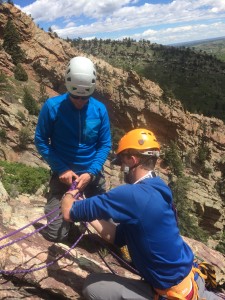
Cheyenne Chaffee getting ready to lower Jake Gaventa at Eldorado Canyon State Park, Colorado. Photo: Mia Tucholke
The course was finally over, Facebook information shared, and we all left for our home or guiding destinations. I appreciate the support and insights from the instructor team and fellow guides. A super crew made this a very memorable and educational experience. It would not have been the same without you all!

